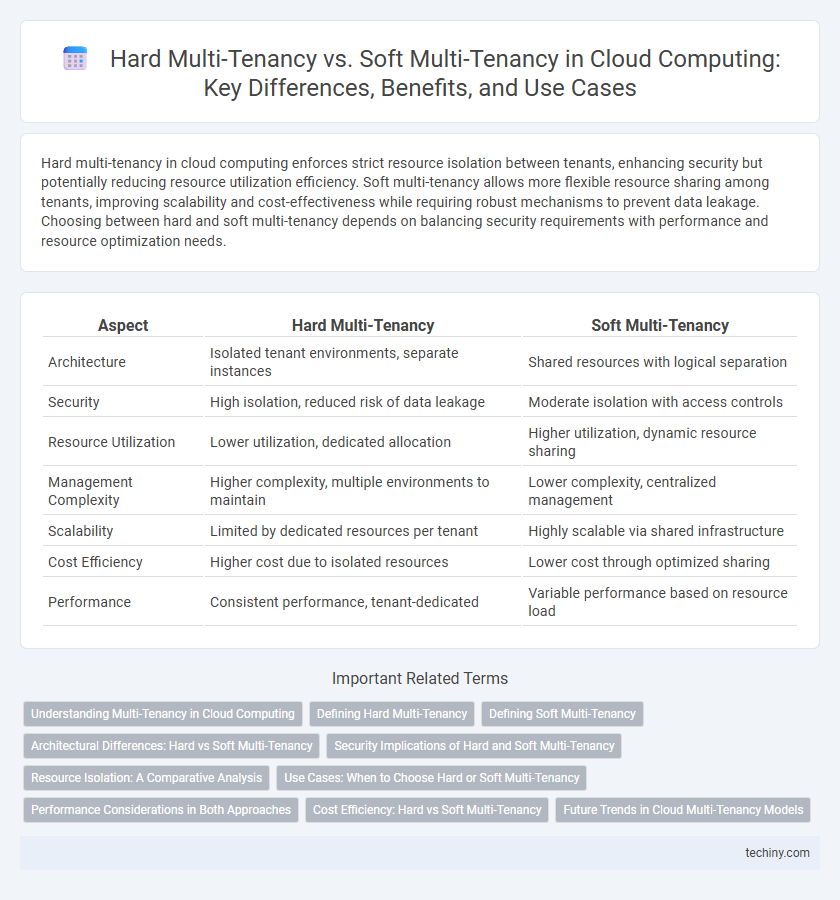Hard multi-tenancy in cloud computing enforces strict resource isolation between tenants, enhancing security but potentially reducing resource utilization efficiency. Soft multi-tenancy allows more flexible resource sharing among tenants, improving scalability and cost-effectiveness while requiring robust mechanisms to prevent data leakage. Choosing between hard and soft multi-tenancy depends on balancing security requirements with performance and resource optimization needs.
Table of Comparison
| Aspect | Hard Multi-Tenancy | Soft Multi-Tenancy |
|---|---|---|
| Architecture | Isolated tenant environments, separate instances | Shared resources with logical separation |
| Security | High isolation, reduced risk of data leakage | Moderate isolation with access controls |
| Resource Utilization | Lower utilization, dedicated allocation | Higher utilization, dynamic resource sharing |
| Management Complexity | Higher complexity, multiple environments to maintain | Lower complexity, centralized management |
| Scalability | Limited by dedicated resources per tenant | Highly scalable via shared infrastructure |
| Cost Efficiency | Higher cost due to isolated resources | Lower cost through optimized sharing |
| Performance | Consistent performance, tenant-dedicated | Variable performance based on resource load |
Understanding Multi-Tenancy in Cloud Computing
Hard multi-tenancy in cloud computing isolates tenant environments through dedicated hardware, ensuring enhanced security and performance but increasing operational costs. Soft multi-tenancy shares computing resources among tenants within a single infrastructure layer, maximizing resource utilization and reducing expenses at the potential cost of data isolation. Understanding these models is crucial for selecting the appropriate cloud architecture based on security requirements, scalability needs, and budget constraints.
Defining Hard Multi-Tenancy
Hard multi-tenancy in cloud computing refers to a strict architectural model where multiple tenants share the same physical resources, such as servers and storage, with clear and enforced isolation at the hardware level. This model ensures robust security and performance guarantees by allocating dedicated resources per tenant, minimizing the risk of data leakage or resource contention. Key implementations of hard multi-tenancy often use virtualization techniques to achieve tenant separation while optimizing hardware usage.
Defining Soft Multi-Tenancy
Soft multi-tenancy in cloud computing refers to the logical separation of resources where multiple users share the same physical infrastructure but operate within isolated virtual environments, enabling better resource allocation flexibility. Unlike hard multi-tenancy, which enforces strict physical or resource partitioning, soft multi-tenancy leverages virtualization technologies such as containers and virtual machines to provide scalable and dynamic resource sharing. This approach facilitates optimized workload distribution, improved cost efficiency, and enhanced application performance without the need for dedicated hardware for each tenant.
Architectural Differences: Hard vs Soft Multi-Tenancy
Hard multi-tenancy architecture isolates tenant environments by using dedicated resources such as virtual machines or containers, ensuring strong security and customized configurations at the cost of higher infrastructure overhead. Soft multi-tenancy relies on shared resources within a common environment, leveraging application-level partitioning and access controls to manage tenant isolation efficiently and reduce operational complexity. The choice between hard and soft multi-tenancy impacts scalability, security, and resource utilization strategies in cloud computing environments.
Security Implications of Hard and Soft Multi-Tenancy
Hard multi-tenancy isolates each tenant on dedicated hardware, significantly reducing the risk of data leakage and unauthorized access, thus enhancing security by minimizing attack surfaces. Soft multi-tenancy shares resources among tenants on the same virtualized infrastructure, increasing efficiency but raising concerns about potential cross-tenant vulnerabilities and data breaches. Effective security measures in soft multi-tenancy require robust isolation techniques, such as containerization and strict access controls, to mitigate risks inherent in shared environments.
Resource Isolation: A Comparative Analysis
Hard multi-tenancy enforces strict resource isolation by allocating dedicated virtual machines or containers per tenant, ensuring uncompromised security and predictable performance. Soft multi-tenancy shares computational resources such as CPU, memory, and storage across tenants with logical separation, optimizing cost-efficiency but introducing potential resource contention. Evaluating trade-offs in resource isolation is critical for cloud providers when balancing security requirements against operational scalability and cost.
Use Cases: When to Choose Hard or Soft Multi-Tenancy
Hard multi-tenancy suits use cases demanding strict data isolation and compliance, such as healthcare and financial services, where regulatory requirements mandate dedicated resources per tenant. Soft multi-tenancy fits scenarios prioritizing resource efficiency and cost-effectiveness, like SaaS applications with large user bases sharing a common infrastructure while maintaining logical separation. Choosing between hard and soft multi-tenancy depends on factors including security requirements, scalability needs, and the degree of data isolation mandated by the business environment.
Performance Considerations in Both Approaches
Hard multi-tenancy isolates tenant resources through dedicated hardware or strict partitioning, resulting in predictable and consistent performance with minimal risk of resource contention. Soft multi-tenancy relies on shared hardware and virtualization, which can introduce variable performance due to noisy neighbors and dynamic resource allocation. Performance optimization in hard multi-tenancy focuses on hardware provisioning, while soft multi-tenancy emphasizes efficient scheduling and workload balancing to mitigate latency and throughput issues.
Cost Efficiency: Hard vs Soft Multi-Tenancy
Hard multi-tenancy offers greater cost efficiency by maximizing resource sharing across multiple tenants on a single infrastructure, reducing hardware and operational expenses. Soft multi-tenancy provides more isolation with dedicated resources for each tenant, leading to higher costs due to underutilized capacity and increased maintenance. Organizations balancing cost efficiency with performance requirements often prefer hard multi-tenancy for scalable cloud environments.
Future Trends in Cloud Multi-Tenancy Models
Future trends in cloud multi-tenancy models emphasize evolving from hard multi-tenancy, where strict resource isolation prevails, to soft multi-tenancy that balances isolation with resource efficiency and scalability. Innovations in containerization and microservices architecture propel soft multi-tenancy adoption, enabling dynamic workload sharing while maintaining security through advanced encryption and access control mechanisms. Artificial intelligence-driven resource allocation and edge computing integration further optimize multi-tenant environments, enhancing performance and reducing latency for globally distributed users.
Hard Multi-Tenancy vs Soft Multi-Tenancy Infographic

 techiny.com
techiny.com